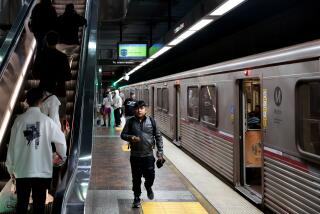More Subway Tunnels Fail to Meet Standard : Transit: Concrete in some areas is thinner than 12-inch specification. But officials say extra steel reinforcing eliminates safety concerns.
- Share via
Transit officials announced Tuesday that 11% of subway tunnels still under construction near Downtown Los Angeles have concrete that is thinner than the design specification of 12 inches.
Officials said they are confident that the tunnels are structurally sound because extra rods of reinforcing steel were added to the thinnest areas--42 feet of tunnel where the walls are 7 to 10 inches thick.
“We’re always working to improve any of our performance, but we feel that given the challenges of mining these tunnels, this performance is satisfactory,” said Joel J. Sandberg, project manager for the Metropolitan Transportation Authority’s construction staff.
Sandberg said he saw no need to seek any remuneration from the contractor, Tutor-Saliba-Perini, because even though some of the tunnels walls are less than 12 inches thick, the opposite wall of those areas has extra concrete.
The MTA announcement came after The Times requested information regarding the thickness of some of the new tunnel areas. The tunnels described by the MTA on Tuesday span 2.9 miles of twin tunnels linking MacArthur Park and a station at Wilshire Boulevard and Western Avenue. The new tunnels are scheduled to open to passengers in 1996.
Two months ago a panel of three transit authority appointees began evaluating the durability and structural soundness of tunnels already in service between Union Station and Pershing Square. The Times reported in August that numerous sections of those tunnels are thinner than 12 inches, with thickness ranging as low as 4.87 inches.
However, there appears to be a major difference between the opened tunnels and the ones under construction. Transit officials said extra rods of reinforcing steel--which provide strength and flexibility during the bending of an earthquake--were added to each of four areas of the new tunnels where the concrete is thinner than 10 inches. Concrete of higher strength than originally required was poured in three of those four areas, officials said.
“In every case where the (newer) tunnel walls are less than 10 inches thick, MTA design engineers required (the contractor) to use higher-strength concrete or extra steel reinforcement to achieve the necessary wall strength,” said Edward McSpedon, president of the agency’s construction staff.
Earlier this year MTA officials said they did not know the extent to which extra steel was placed in the problem areas of the tunnels from Union Station to Pershing Square. Radar testing performed for the transit agency in 1992 found that up to 2,082 feet of those tunnels may be 6 to 8 inches thick. Officials say they have buttressed the areas where they thought it necessary and have said the tunnels are structurally sound.
Ronald N. Tutor, managing partner of the joint venture that built both of the newest tunnels, said he is satisfied with the work and documentation. “The paperwork in support of the (newer) tunnels is as close to perfect as we can be in an imperfect world,” Tutor said.
More to Read
Sign up for Essential California
The most important California stories and recommendations in your inbox every morning.
You may occasionally receive promotional content from the Los Angeles Times.














